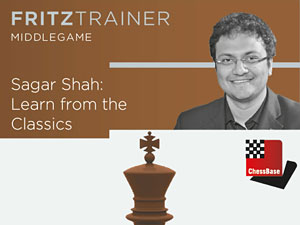Sagar Shah: Learn from the Classics
Review – part two
– Read the first part of this review here –
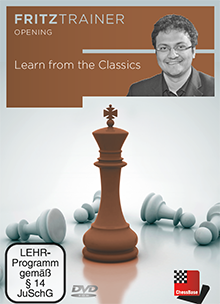
Surfing the ChessBase website for news and the ChessBase shop for new products has now become a part of my daily routine. A couple of days ago I was doing the routine check-up and found a new ChessBase DVD: Learn from the Classics by a prolific columnist of this news page, Sagar Shah. With his wonderful and easy-to-understand write-ups on chess Sagar has succeeded in drawing a lot of attention of not only the professional players but also of a lot of amateurs and chess lovers across the world! I started viewing the videos immediately after its launch and hoped that, just like his columns, his teaching too will unleash some wonderful chess secrets to me!
The biggest surprise is when Sagar takes us back in his time machine to the year 1963 and shows how we can study openings through classics! He explains the intricacies of the Queen’s Gambit Accepted through the World Championship games of Botvinnik and Petrosian. The opening is very well chosen for us. QGA does not mean just a fixed set of moves in the initial part of the game, but it also means studying the very important isolated queen’s pawn structures and the ideas for both sides. In four of the six games, we get IQP structures and learn a lot about them.

The next white move is the most important motif in IQP positions,
and both the players have to watch out for it. You know it! Don’t you?
The right move is 13.d5, blasting open the centre. The d1 rook in front of the opponent’s queen will cause a lot of difficulties to Black. The Indian International Master points out that the main problem that we face when calculating such moves is that there are too many recaptures by the opponent and this can sometimes confuse us. Here he has a very simple but effective piece of advice: “the secret is to take one move at a time!” This is important for a person like me: the moment a lot of work crops up in life, or too many variations come up in calculations, I get completely confused. That is the time I have to consciously remind (discipline) myself: "Nisha, do one thing at a time and the task will become easier!" I have tried it with kids. There are positions when they can't calculate. I have made them do loud calculation — one move at a time. That has proved effective.
The Botvinnik-Petrosian games were shown so enthusiastically round-by-round wherever QGA was played that for some time I actually forgot that I was in the year 2015 and was curious what improvement each side came up with in the next game. It felt as if I was in the year 1963 and was watching the match with live commentary! Very often we change our opening lines after we lose a game. What is very interesting to note for all of us is that Petrosian did not deviate from his pet system when he had problems in his games but instead came up with improvements in the next games! We learn how the battle of opening theory develops between two good players.
One of the best methods to learn chess is by understanding the plans in different pawn structures. Moves may vary in different games, but pawn formations are limited and so their knowledge is very useful. Shah is a self-tutored player and knows exactly how to become better at chess! I like how he explains ideas at the end of each section by focusing on the relevant pawn structures.
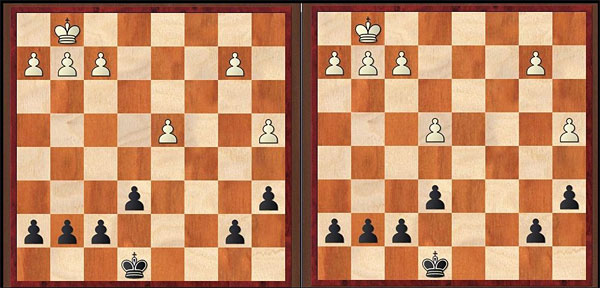
We get to learn how to handle these pawn skeletons through the Botvinnik-Petrosian games. The former is an IQP structure where the d5 square plays an important role, whereas in the latter diagram play revolves around the central dark squares d4 and e5.
Be it an opening DVD or a one in classics, my eyes always look out for tactics!
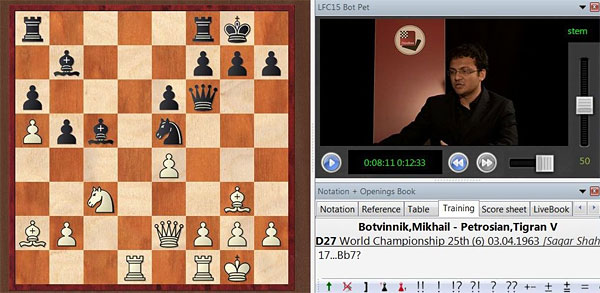
A nice position to train our tactics! Can you spot White’s next move
and the follow-up in this position from the analysis of a Botvinnik-Petrosian game?

[Event "World Championship 25th"] [Site "Moscow"] [Date "1963.04.03"] [Round "6"] [White "Botvinnik, Mikhail"] [Black "Petrosian, Tigran V"] [Result "*"] [ECO "D27"] [Annotator "Sagar Shah"] [SetUp "1"] [FEN "r4rk1/1b3ppp/p3pq2/Ppb1n3/4P3/2N3B1/BP2QPPP/3R1RK1 w - - 0 18"] [PlyCount "17"] [EventDate "1963.03.23"] [EventRounds "22"] [EventCountry "URS"] {This position is a part of the analysis of the game, not the actual game. But I found it very instructive [Nisha Mohota]} 18. Qh5 $1 {[%csl Rc5][%cal Gh5e5, Gg3e5]} g5 19. Bxe5 Qxe5 20. Bxe6 $3 fxe6 21. Rd7 Bxf2+ (21... Bxe4 22. Nxe4 Qxe4 23. Qxg5+ $18) 22. Rxf2 (22. Kh1 Bxe4 $19) 22... Bxe4 23. Nxe4 Qxe4 24. Qxg5+ Qg6 25. Qxg6+ hxg6 26. Re7 $16 *
The Indian author is a good story-teller. One example which made an impression in my mind was about the great thinker Nimzowitsch who used to form his own theories and follow them. In 1906, Nimzowitsch was struggling with his chess. He got hold of a tournament book and took it to a binder and told him to insert blank pages where he could write down his analysis. He would take the side of a player, thinking about each and every one of his moves, and would then compare with the actual game. In this way, he could understand the difference between his thinking and the master’s thinking, and that helped him succeed! Sagar tells us that we could have the same critical approach towards the classics. This will take us a long way to become a better player!
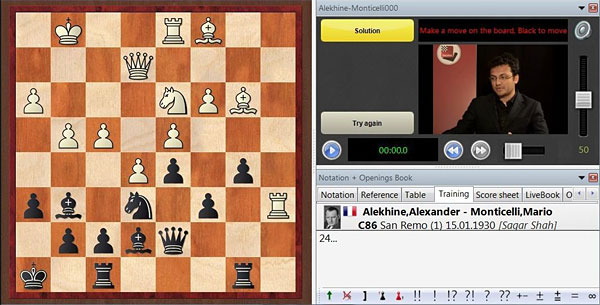
The fierce attacker Alekhine is pushing his pawns at the opponent’s king and is threatening f5.
Monticelli missed a nice move here. Can you spot it?
Counter-attack is the best defence! The right move is 24...b4! The author explains in his lucid style: “When your opponent is trying to attack you on the kingside you should not be too worried all the time. Sometimes you should try to create play on the opposite wing which will distract your opponent”.
When I watch a DVD, I try to learn more from the words of the authors rather than the moves they show. Ideas are more important than moves. Similarly, general advice is more effective than a few set patterns. Sagar tells us that when our position changes from good to bad we should not get upset. We should try to reorganise ourselves to the new situation and fight. Anand had echoed the same in a recent interview and pointed out that Karpov was very good at exactly this!
What Sagar has done for teaching us endgames and for familiarising us with the great players of the past is really commendable. He has selected one of the greatest tournaments of that time, San Remo 1930, and has extracted positions for us after going through all the 120 games! We get to enjoy the fruits of his hard work!

A beautiful example of complete zugzwang! Black will soon run out of moves on the kingside
I completely enjoyed my journey into the world of famous chess games with the enthusiastic author! He has made me hungry for more knowledge of the classics, but more importantly, he has taught me how to make use of them to become a better player. I will end with some inspiring words of his: “Rather than spending a month studying some razor-sharp lines, you should study the classics. Imagine: you are playing a game and you say to yourself – ah, the third game of the match between Steinitz and Zukertort, that is the idea I should use here! When you get to that level of classical knowledge nothing can stop you from becoming a strong player!”
 Learn from the Classics Learn from the Classics
By IM Sagar Shah
Languages: English
ISBN : 978-3-86681-500-1
Delivery: Download, Post
Level: Tournament player, Professional
Price: €29.90 or €25.13 without VAT (for Customers outside the EU) $27.06 (without VAT)
Wise and successful players of the game have always told us to study the classics – games by the great masters of the past. But in this age of cutting-edge opening theory, preparation and engines, is studying the classics really that helpful?
On this DVD, Sagar Shah doesn't merely preach. First, he shows you classical games of great legends such as Petrosian, Botvinnik, Fischer, Korchnoi and Kasparov, looking at typical patterns and ideas from the middlegame. The author then goes on to explain how you can use these ideas in your own battles – by showing you examples of applied classical knowledge from his own games!
As well as looking at the middlegame, Sagar also focuses on the opening. The information explosion has ensured that opening theory continues to evolve at a rapid pace. The author shows that playing through the classics can help us establish a strong and stable feel for the initial phase of the game, and analyzes the opening duel between Botvinnik and Petrosian from their World Championship match in 1963. Going over these games will give you an excellent idea of how the classics can be used to prepare your own openings.
Order Sagar Shah's Learn from the Classics in the ChessBase Shop |
